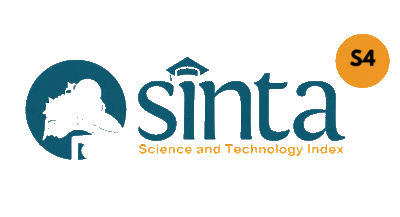SISTEM IDENTIFIKASI DINI PENYAKIT STROKE DENGAN MENGGUNAKAN JARINGAN SYARAF TIRUAN PERAMBATAN BALIK
DOI:
https://doi.org/10.47111/jti.v16i2.5096Keywords:
Prediksi Stroke, Klasifikasi, Kesehatan, Jaringan Syaraf Tiruan, Jaringan Perambatan BalikAbstract
Heart disease is a disease with the second-highest mortality rate in the world. This happens because of an unhealthy human lifestyle. This unhealthy lifestyle affects the performance of the body's organs in carrying out their functions. Stroke can be prevented by exercising regularly, eating nutritious foods, not consuming alcohol, and not consuming tobacco. One way to find out if someone is free from stroke or not can be done by medical check-ups. However, this method is quite expensive. Given these problems, this study aims to design an early identification system for detecting early-stage stroke. The system is designed by utilizing the condition and history of the subject for identification. This study uses a back propagation neural network for the classification process. Variations in the use of hidden layers in each experiment were used to obtain the highest accuracy in the training process. From the results of the study, it was found that the system designed can detect early stroke with an accuracy rate of 97.8%.
Downloads
References
S. Poonam Khetrapal, “World Stroke Day,” WHO Regional Director for South-East Asia, Oct. 28, 2021. https://www.who.int/southeastasia/news/detail/28-10-2021-world-stroke. (accessed Jul. 03, 2022).
L. Mustika Sari, A. Yuliano, and Stik. Perintis Padang, “Jurnal Kesehatan Perintis (Perintis’s,” Health Journal, vol. 6, 2019.
S. Atmaja, “Decision Support System For Early Detection Of Stroke Disease Risk Using Learning Vector Quantization,” 2019. [Online]. Available: http://journal.umg.ac.id/index.php/indexia/29
P. Se Jin, H. Iqram, H. Seunghee, K. Damee, P. Hongkyu, and M. B. Ho Chee, “Real-time Gait Monitoring System for Consumer Stroke Prediction Service,” 2020.
A. Ponmalar, G. Nokudaiyaval, R. Vishnu Kirthiga, P. Pavithra, and R. V. T. Sri Rakshya, “Stroke Prediction System Using Artificial Neural Network,” in Proceedings of the 6th International Conference on Communication and Electronics Systems, ICCES 2021, Jul. 2021, pp. 1898–1902. doi: 10.1109/ICCES51350.2021.9489055.
R. K. Kavitha, W. Jaisingh, and S. R. Sujithra, “Applying Machine Learning Techniques for Stroke Prediction in Patients,” 2021. doi: 10.1109/ICAECA52838.2021.9675652.
V. Jalajajayalakshmi, V. Geetha, and M. M. Ijaz, “Analysis and Prediction of Stroke using Machine Learning Algorithms,” 2021. doi: 10.1109/ICAECA52838.2021.9675545.
N. Abbas Al-Sammarraie, Y. Mahdi Hadi Al-Mayali, and Y. ABaker El-Ebiary, “Classification and diagnosis using back propagation Artificial Neural Networks (ANN); Classification and diagnosis using back propagation Artificial Neural Networks (ANN),” 2018.
S. Dev, H. Wang, C. S. Nwosu, N. Jain, B. Veeravalli, and D. John, “A predictive analytics approach for stroke prediction using machine learning and neural networks,” Healthcare Analytics, vol. 2, p. 100032, Nov. 2022, doi: 10.1016/j.health.2022.100032.
L. S. A. Putra and V. A. Gunawan, “Identification of Heart Disease With Iridology Using Backpropagation Neural Network,” 2018.
Fedesoriano, “Stroke Prediction Dataset _ Kaggle,” 2021. https://www.kaggle.com/datasets/fedesoriano/stroke-prediction. (accessed Jun. 15, 2022).
D. P. Indraswari, A. A. Soebroto, and E. A. Marhaendraputro, “SISTEM PENDUKUNG KEPUTUSAN DETEKSI DINI PENYAKIT STROKE MENGGUNAKAN METODE DEMPSTER-SHAFER,” Journal of Environmental Engineering & Sustainable Technology JEEST, vol. 02, no. 02, pp. 97–104, 2015, [Online]. Available: http://jeest.ub.ac.id
R. Harikumar and K. P. Sunil, “Hilbert Transform with Elman Backpropagation and Multilayer Perceptrons for Epilepsy Classification,” 2017.
Q. T. A. Safdar and K. U. Khan, “Online Urdu Handwritten Character Recognition: Initial Half Form Single Stroke Characters,” in Proceedings - 12th International Conference on Frontiers of Information Technology, FIT 2014, Jun. 2015, pp. 292–297. doi: 10.1109/FIT.2014.61.
N. Abbas Al-Sammarraie, Y. Mahdi Hadi Al-Mayali, and Y. ABaker El-Ebiary, “Classification and diagnosis using back propagation Artificial Neural Networks (ANN); Classification and diagnosis using back propagation Artificial Neural Networks (ANN),” 2018.
J. Parab, M. Sequeira, M. Lanjewar, C. Pinto, and G. Naik, “Backpropagation Neural Network-Based Machine Learning Model for Prediction of Blood Urea and Glucose in CKD Patients,” IEEE Journal of Translational Engineering in Health and Medicine, vol. 9, pp. 1–8, 2021, doi: 10.1109/JTEHM.2021.3079714.
Y. Fan and W. Yang, “A backpropagation learning algorithm with graph regularization for feedforward neural networks,” Information Sciences, vol. 607, pp. 263–277, Aug. 2022, doi: 10.1016/j.ins.2022.05.121.
L. Zhang, H. Cui, B. Liu, C. Zhang, and B. K. P. Horn, “Backpropagation Neural Network for Processing of Missing Data in Breast Cancer Detection,” IRBM, vol. 42, no. 6. Elsevier Masson s.r.l., pp. 435–441, Dec. 01, 2021. doi: 10.1016/j.irbm.2021.06.010.
E. Contessa Djamal, M. Amara, D. Djajasasmita, and S. Lesmana Liem Limanjaya, “Learning Optimization Using Genetic Algorithm in Post-Stroke EEG Signal Classification,” Dec. 2020, pp. 1–5. doi: 10.1109/icic50835.2020.9288559.
S. Chakrabarti, H. N. Saha, Čhulālongkō̜nmahāwitthayālai. Sasin Graduate Institute of Business Administration, Institute of Engineering & Management, University of Engineering & Management, and Institute of Electrical and Electronics Engineers, “Stroke Prediction using Artificial Intelligence,” 2017.












